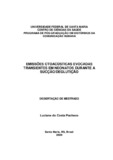| dc.creator | Pacheco, Luciane da Costa | |
| dc.date.accessioned | 2009-09-10 | |
| dc.date.available | 2009-09-10 | |
| dc.date.issued | 2009-07-22 | |
| dc.identifier.citation | PACHECO, Luciane da Costa. TRANSIENT EVOKED OTOACOUSTIC EMISSIONS IN NEONATES
DURING SUCKING. 2009. 81 f. Dissertação (Mestrado em Fonoaudiologia) - Universidade Federal de Santa Maria, Santa Maria, 2009. | por |
| dc.identifier.uri | http://repositorio.ufsm.br/handle/1/6457 | |
| dc.description.abstract | Objective: To verify if the noise caused by sucking and swallowing mechanisms interferes in the quality of transient evoked otoacoustic emissions (TEOAE) in
neonates with and without risk indicators for hearing loss by comparing the responses without sucking with situations of non-nutritive sucking, breast-feeding nutritive sucking and bottle-feeding nutritive sucking. Methods: a study carried out with 53 neonates (13 with risk indicators for hearing loss), evaluated with TEOAE, at rest and in three different cases: non-nutritive sucking, breast-feeding nutritive sucking and bottle-feeding nutritive sucking. Results: Studying the different types of sucking, it was found that the greater incidence of failure occurred at the frequency of 2000 Hz for all the three types of sucking. An increase in the noise intensity was observed in all frequencies during the capture of TEOAE in the left ear in all types of sucking studied. At 1400, 2000, 2800, and 4000 Hz, the signal to noise ratio decreased in the left ear during sucking. In breast-feeding nutritive sucking, the noise levels were lower at 1400 Hz and the signal to noise ratio was higher at the same frequency as well as at 2000 Hz. When neonates were compared regarding the presence or not of risk indicators for hearing loss, the seconds during non-sucking situation showed higher amplitude of TEOAE at the frequencies of 700, 1000, 2000,
and 4000 Hz, and at 1000 and 4000 Hz during sucking. In both groups, a decrease in the amplitude of TEOAE and in the noise at 700 Hz during sucking was observed. At the other frequencies, the noise level increased in the sucking situation. There was no change in the signal to noise ratio between the conditions of sucking and nonsucking at 700 and 1000 Hz. At 1400 Hz, the sucking impaired the signal to noise ratio causing absence of response. At 2000, 2800, and 4000 Hz, the signal to noise
ratio remained greater than 6 dB. Conclusions: The evaluation of TEOAE during sucking can be performed in neonates with and without risk indicators for hearing
loss, since the criteria of presence/absence are achieved in at least three frequencies studied. | eng |
| dc.format | application/pdf | por |
| dc.language | por | por |
| dc.publisher | Universidade Federal de Santa Maria | por |
| dc.rights | Acesso Aberto | por |
| dc.subject | Emissões otoacústicas | por |
| dc.subject | Indicador de risco | por |
| dc.subject | Sucção | por |
| dc.subject | Neonatos | por |
| dc.subject | Otoacoustic emissions | eng |
| dc.subject | Risk indicator | eng |
| dc.subject | Sucking | eng |
| dc.subject | Neonates | eng |
| dc.title | Emissões otoacústicas evocadas transientes em
neonatos durante a sucção/deglutição | por |
| dc.title.alternative | Transient evoked otoacoustic emissions in neonates
during sucking | eng |
| dc.type | Dissertação | por |
| dc.description.resumo | Objetivo:verificar se os ruídos provocados pelo mecanismo de sucção/deglutiçãointerferem na amplitude das Emissões Otoacústicas Evocadas Transientes(EOAETs) em neonatos com e sem indicadores de risco para perda auditiva,
comparando as respostas sem sucção com as situações de sucção não nutritiva,sucção nutritiva no peito materno e em sucção nutritiva em mamadeira. Métodos:estudo realizado com 53 neonatos (13 com indicadores de risco para deficiência
auditiva), avaliados com EOAETs, em repouso e em três situações de sucção:sucção não nutritiva, sucção nutritiva no peito materno e sucção nutritiva na mamadeira. Resultados: em 700, 1000, 2000 e 4000 Hz a amplitude foi maior no grupo sem indicadores de risco, e na situação de sucção, apenas em 1000 e 4000Hz. Em 700 Hz observou-se diminuição na amplitude das EOAETs e do ruído, quando mensuradas durante a sucção. O nível de ruído aumentou em sucção. Em 700 e 1000 Hz não houve variação da relação sinal/ruído entre as duas situações. Em 1400 Hz a sucção prejudicou a relação sinal/ruído, provocando ausência de
respostas. Em 2000, 2800 e 4000 Hz a variável se manteve superior a seis dB. Constatou-se na freqüência de 2000 Hz maior ocorrência de falha durante a sucção. Analisando a variável ruído, em todas as freqüências houve aumento de sua
intensidade durante a avaliação das EOAETs em sucção na orelha esquerda. Em 1400, 2000, 2800 e 4000 Hz houve interferência também na relação sinal/ruído, que diminuiu na orelha esquerda, durante a sucção. Encontrou-se níveis de ruído menores em 1400 Hz, durante a avaliação das EOAETs em sucção nutritiva no peito, e relação sinal/ruído maior na mesma freqüência e em 2000 Hz. Conclusões: A avaliação das EOAETs durante a sucção pode ser executada em neonatos com e sem indicadores de risco para deficiência auditiva, já que os critérios de presença/ausência são atingidos em pelo menos três freqüências analisadas e as alterações produzidas com esta estratégia não prejudicam as respostas ao ponto de
evidenciar resultados falso/positivos. | por |
| dc.contributor.advisor1 | Tochetto, Tania Maria | |
| dc.contributor.advisor1Lattes | http://buscatextual.cnpq.br/buscatextual/visualizacv.do?id=K4787974J5 | por |
| dc.contributor.referee1 | Teixeira, Adriane Ribeiro | |
| dc.contributor.referee1Lattes | http://buscatextual.cnpq.br/buscatextual/visualizacv.do?id=K4704019Y6 | por |
| dc.contributor.referee2 | Silveira, Aron Ferreira da | |
| dc.contributor.referee2Lattes | http://buscatextual.cnpq.br/buscatextual/visualizacv.do?id=K4705548P6 | por |
| dc.creator.Lattes | http://buscatextual.cnpq.br/buscatextual/visualizacv.do?id=K4592641Y3 | por |
| dc.publisher.country | BR | por |
| dc.publisher.department | Fonoaudiologia | por |
| dc.publisher.initials | UFSM | por |
| dc.publisher.program | Programa de Pós-Graduação em Distúrbios da Comunicação Humana | por |
| dc.subject.cnpq | CNPQ::CIENCIAS DA SAUDE::FONOAUDIOLOGIA | por |


